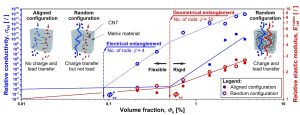Research group at Laboratory for Experimental Mechanics (LEM), Faculty of Mechanical Engineering in collaboration with the groups at Department of Surface Engineering and Electronic Ceramics Department, Institute Jožef Stefan (IJS), and Department of Chemical and Biological Engineering, University of British Columbia (UBC) conducted a theoretical and experimental study in the field of carbon nanocomposites, which deals with the effect of carbon nanotube (CNT) network formation and configuration on reinforcing and conductive performance of such materials. The results of the research were published in a recognized journal in the field of material sciences, i.e. Composites Science and Technology (IF=9,879).
Rod-like geometry, exceptional strength and effective electron transfer are some of the remarkable properties that make carbon nanotubes – CNTs superior functional nanofillers in polymer-based nanocomposites. Their anisotropic geometric configuration as rod-like particles allows them to establish a randomly connected web (network) in the matrix material. In the light of the inherent properties of CNTs, the network can serve as a mechanical reinforcement or conductive pathway, which can be utilized in numerous current or future-emerging technologies from smart structural elements to flexible devices on various fields.
Results showed that the reinforcing and conductive performance of CNT polymer-based nanocomposites strongly depends, not only on the network formation, but also on its configuration. While network configuration does not have any significant effect on the mechanical reinforcement, which only depends on its formation (the geometric entanglement of CNTs defined by the volume fraction ɸcv); it has a significant effect on the conductive properties of such materials. It turns out that the random configuration significantly reduces the transition of the material from insulator to conductor (the electrical entanglement of CNTs defined by the volume fraction ɸcve) and thus greatly improves the electrical conductivity of the nanocomposites, even though the network is not fully established (ɸcve << ɸcv). This key discovery enables the production of not only highly reinforced and conductive nanocomposites, but also those with exceptional conductivity and flexibility with minimal addition of CNTs.

Figure: Graphical summary of the research on the effect of CNT network formation and configuration on reinforcing and conductive performance of nanocomposites.
Link to the article: https://doi.org/10.1016/j.compscitech.2023.110010.